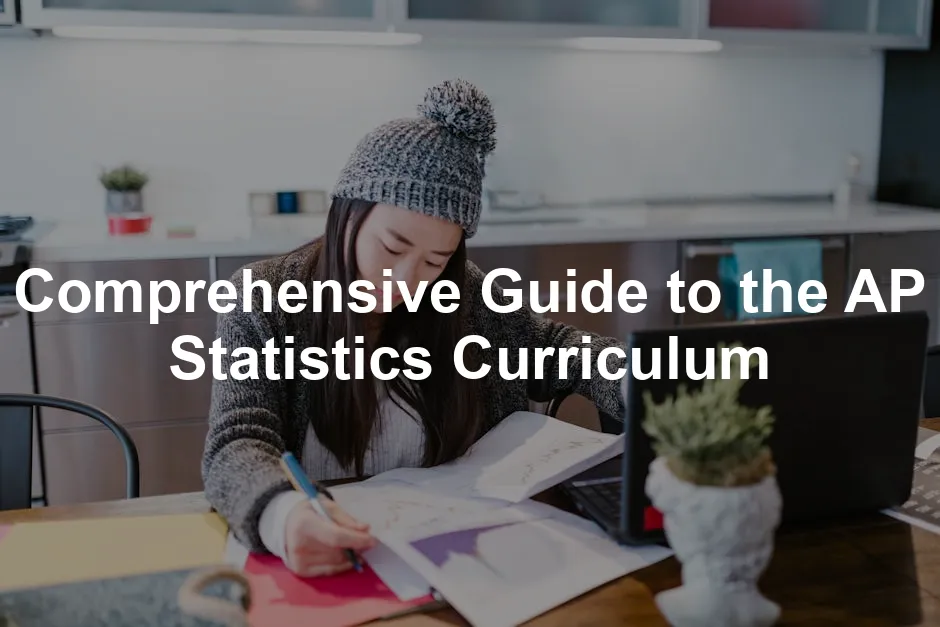Introduction
Welcome to the intriguing world of AP Statistics! This course is not just a class; it’s an academic adventure that unravels the mysteries behind data. Designed for high school students, AP Statistics is equivalent to a one-semester college-level statistics course. It’s a chance for students to step into the shoes of a statistician, wielding numbers like a wizard commands spells.
But why should you care? Well, taking AP Statistics comes with some serious perks. First off, many colleges grant credit for a high score on the AP exam. This means you could skip introductory courses in college, saving time and money. Plus, you’ll develop invaluable analytical skills that are in demand across various fields—think business, healthcare, and social sciences.
In this blog post, we’ll explore the AP Statistics curriculum structure, the essential skills you’ll acquire, valuable resources for studying, and the nitty-gritty details about the exam itself. By the end, you’ll have a clear roadmap to navigate through this fascinating subject with confidence. So, grab your TI-84 Plus CE Graphing Calculator and let’s get started on this statistical journey!

1. Understanding the AP Statistics Course
1.1 Course Overview
AP Statistics is a deep dive into the world of data, designed for high school juniors and seniors. This course introduces students to the major concepts and tools for collecting, analyzing, and drawing conclusions from data. Think of it as your statistical toolkit, packed with everything you need to tackle real-world problems.
The curriculum mirrors a college-level introductory statistics course, focusing on the practical application of statistics rather than just theory. Students will engage with various statistical methods, learn to interpret results, and apply their newfound knowledge to diverse scenarios. From examining data distributions to crafting hypotheses, AP Statistics equips you with essential skills for future academic pursuits or careers.
One key aspect of the course is its emphasis on exploring concepts through technology and hands-on investigations. Students will not just passively absorb information; they will get their hands dirty with real data, making the learning process dynamic and engaging. Don’t forget to stock up on Graph Paper Notebooks for those scatterplots!
As you embark on this educational journey, remember that AP Statistics is not just about crunching numbers. It’s about learning to think critically, make informed decisions, and communicate findings effectively. Whether you’re looking to pursue a career in data science, psychology, economics, or any field that relies on data-driven insights, this course lays a solid foundation for your future endeavors.
So, if you’re ready to embrace the world of statistics, buckle up! The AP Statistics course awaits, promising an experience filled with exploration, analysis, and the thrill of discovery.

1.2 Importance of AP Statistics
Statistics isn’t just about crunching numbers. It’s like the magic wand of the modern world! Within various fields, statistics plays a crucial role in shaping decisions and guiding actions. Let’s break it down, shall we?
In social sciences, statistics helps researchers analyze trends and behaviors. For example, a sociologist might use statistical methods to understand voting patterns. This can lead to insights that influence policy decisions. Now that’s some serious power!
Economists harness the power of statistics to forecast market trends. They analyze data to make predictions about inflation or unemployment. Imagine being able to predict which way the economy will sway! That’s the kind of crystal ball effect statistics provides.
In healthcare, statistics is pivotal. Medical researchers rely on data to evaluate treatment effectiveness. Clinical trials utilize statistics to determine whether a new drug is safe and effective. Without statistics, our understanding of health would be as reliable as a fortune cookie!
Given our data-driven world, statistical literacy is essential. It empowers individuals to make informed decisions. Whether you’re assessing risks, interpreting news articles, or deciphering social media data, statistics is your trusty sidekick.
So, why does AP Statistics matter? It equips students with valuable skills. You’ll learn how to collect, analyze, and interpret data like a pro. Plus, the ability to evaluate data critically is a superpower in today’s information-heavy society.
In short, AP Statistics is your gateway to understanding the world around you. It teaches you to think critically and make decisions backed by data. That’s a skill worth having, don’t you think? And what better way to enhance your skills than with a Statistics for Dummies book?

Unit 2: Exploring Two-Variable Data
Unit 2 is where things get a bit spicy! This unit focuses on two-variable data, which means we’re diving into the correlations and relationships between different variables. Get ready for scatterplots, regression lines, and determining if one variable is truly influencing another.
Key topics include analyzing relationships, calculating correlation coefficients, and interpreting linear regression models. Students will also learn how to identify outliers and understand their impact on data interpretation. These skills are crucial for making sense of data in real-life situations, whether you’re scrutinizing social media trends or assessing sports performance.
In terms of exam weightage, this unit accounts for about 5% to 7% of the overall AP Statistics exam. While it may seem small, mastering these concepts can significantly enhance your analytical abilities, setting a solid foundation for further statistical analysis. So, keep your pens ready and your minds sharp as we explore the fascinating connections between variables!

Unit 3: Collecting Data
Welcome to Unit 3, where we roll up our sleeves and get our hands dirty with the nitty-gritty of data collection! This unit covers essential principles of sampling and experimental design, equipping students with the skills needed to gather high-quality data. After all, you can’t analyze what you don’t collect!
Key topics include understanding different sampling methods, like random sampling and stratified sampling, and their importance in minimizing bias. Students will explore the significance of experimental design, including the concepts of control groups and randomization. This knowledge is fundamental for conducting valid experiments and surveys.
Additionally, students will learn about observational studies, surveys, and the role of variables in data collection. It’s vital to differentiate between causation and correlation, as this can change the way we interpret data entirely. To aid in your data collection, a Data Analysis and Statistics Workbook can be a great resource!
This unit carries a solid exam weightage of 12% to 15%. Gaining proficiency in data collection techniques not only prepares students for the AP exam but also equips them with invaluable skills for future research projects or real-world applications. So, let’s get out there and collect some data!
Unit 4: Probability, Random Variables, and Probability Distributions
Time to roll the dice! Unit 4 dives into the thrilling world of probability and random variables. This unit is all about predicting outcomes and understanding the role of randomness in statistics. Students will learn fundamental principles of probability, such as the addition and multiplication rules.
Key topics include the concept of random variables, probability distributions, and expected values. Students will explore discrete and continuous random variables, gaining insight into how different distributions work. The normal distribution, often referred to as the “bell curve,” will also be a focal point. This is vital since many statistical tests rely on the assumption of normality.
The weightage for this unit is significant, ranging from 10% to 20%. Understanding probability not only enhances critical thinking skills but also prepares students for real-world decision-making under uncertainty. Whether you’re making financial investments or predicting sports outcomes, this unit arms you with the knowledge to assess risks and make informed choices confidently. Speaking of informed choices, check out Probability Theory: A Comprehensive Course for a deeper dive!

Unit 5: Sampling Distributions
In Unit 5, we continue our exploration of statistics with a focus on sampling distributions. This unit is crucial for understanding how sample data can represent a larger population. Students will learn about the Central Limit Theorem, which lays the groundwork for many inferential statistics concepts.
Key topics include the distribution of sample means, standard error, and how to construct confidence intervals. Students will also explore the difference between population parameters and sample statistics, helping them understand the variability that occurs when sampling.
This unit’s exam weightage sits between 7% and 12%. Mastering sampling distributions is essential for making valid conclusions from data. It’s the bridge between descriptive statistics and inferential statistics, allowing students to make predictions about a population based on sample data. For additional practice, consider a Probability and Statistics Workbook to strengthen your skills!

Unit 6: Inference for Categorical Data: Proportions
Jumping into Unit 6, we’ll tackle inference for categorical data, specifically focusing on proportions. This unit is all about making predictions and decisions based on categorical data. Students will learn how to construct confidence intervals and conduct significance tests for proportions.
Key topics include hypothesis testing, understanding p-values, and determining whether to reject or fail to reject the null hypothesis. Students will also explore the concept of margin of error and its significance in interpreting results.
This unit carries a weightage of 12% to 15% on the exam. Mastering these concepts is vital for making data-driven decisions, whether you’re analyzing survey results or assessing election polls. To help with your studies, grab a set of Statistics Quiz Cards to test your knowledge!

Unit 7: Inference for Quantitative Data: Means
Unit 7 takes a deep dive into inference for quantitative data, specifically focusing on means. This unit enables students to make predictions and decisions about population means based on sample data. It’s all about understanding the power of averages!
Key topics include constructing confidence intervals for means and performing hypothesis tests. Students will learn how to calculate t-scores and z-scores and understand when to use each. The importance of sample size and variability in drawing conclusions will also be emphasized.
This unit has an exam weightage of 10% to 18%. Mastering inference for means is essential for students looking to analyze quantitative data effectively. Whether assessing test scores or evaluating product performance, these skills are invaluable for interpreting and communicating findings. If you’re looking for a comprehensive resource, check out The Art of Statistics: Learning from Data.

Unit 8: Inference for Categorical Data: Chi-Square
Unit 8 is where we get our detective hats on! This unit dives into inference for categorical data using the Chi-Square test. Think of it as a statistical sleuthing tool, helping us determine if there’s a significant association between two categorical variables.
Key topics include conducting Chi-Square tests for independence and goodness of fit. Students will learn how to interpret the results and understand when to use this test effectively. With an exam weightage of 2% to 5%, mastering these concepts can boost your overall statistical skills. This unit is essential for making data-driven decisions in fields like marketing, social sciences, and healthcare. To further enhance your learning, consider the Graphing Calculators for Dummies.
Unit 9: Inference for Quantitative Data: Slopes
Unit 9 is all about slopes—no, not the kind you ski down! Here, we focus on inference for quantitative data, particularly in the context of regression analysis. Students will learn to construct confidence intervals for slope estimates and perform hypothesis tests on regression slopes.
Key topics include understanding how slope indicates the relationship between variables and how to interpret these relationships in real-world scenarios. This unit also carries an exam weightage of 2% to 5%. Grasping these concepts is crucial for anyone looking to analyze trends and make predictions based on data. Whether in economics, environmental studies, or any field that involves statistics, this knowledge is a must-have!

4. Resources for Success in AP Statistics
4.1 Recommended Textbooks and Materials
When it comes to mastering AP Statistics, the right resources can make all the difference. Here are some popular textbooks that have earned their stripes in classrooms:
1. The Practice of Statistics – This book is like your trusty sidekick, guiding you through every statistical concept with clarity and humor. You can get your copy here.
2. Stats: Modeling the World – A favorite among teachers, it uses real-world examples to explain complex ideas. Grab it here.
3. Statistics by David Freedman – A more challenging read, perfect for those ready to take a deep dive into statistical theory. Check it out here.
For a free resource, check out Introductory Statistics by Barbara Illowsky & Susan Dean. It’s a fantastic way to get started without breaking the bank! You can find it here.
These textbooks equip students with the foundational knowledge and practical skills needed to tackle the AP exam confidently. And don’t forget to have a Scientific Calculator handy!

4.2 Online Platforms and Tools
In today’s tech-savvy world, using online tools can turn the daunting task of statistics into a walk in the park. Graphing calculators are a must-have, and the TI-84 is the gold standard in many classrooms. It’s like having a mini-computer that helps you perform calculations, plot graphs, and analyze data.
Don’t overlook software like Desmos! This online graphing tool is user-friendly and offers interactive simulations that bring statistical concepts to life. Plus, it’s perfect for visual learners who appreciate a little color in their graphs. And if you’re serious about your data analysis, consider investing in Statistical Analysis Software (e.g., SPSS).
For practice exams and tutorials, websites like Khan Academy and AP Classroom provide invaluable resources. They offer free practice questions and videos that explain tricky concepts. So, whether it’s mastering the Central Limit Theorem or perfecting your scatterplot skills, these platforms have your back.

4.3 Study Strategies
Now that you have the resources, how do you effectively study? Here are some golden nuggets of wisdom:
1. Practice Tests: Take as many practice exams as possible. They mimic the real deal and help you get comfortable with the format. Plus, they reveal your strengths and weaknesses.
2. Group Studies: Team up with classmates for study sessions. Teaching others is a great way to reinforce your understanding while making math less lonely.
3. Conceptual Understanding: Focus on grasping concepts rather than memorizing formulas. Statistics is all about understanding relationships and patterns. Rote memorization will only get you so far!
4. Online Resources: Utilize free online resources. Websites, forums, and YouTube channels can provide explanations and tips that textbooks might gloss over. And to keep your study space organized, check out a Desk Organizer to keep your materials in check!
By mixing and matching these strategies, you’ll create a personalized study plan that keeps you engaged and ready for exam day. Statistics might seem like a maze, but with the right tools and tactics, you’ll navigate through it like a pro!
Please let us know what you think about our content by leaving a comment down below!
Thank you for reading till here 🙂
To gain a comprehensive understanding of the essential formulas needed for AP Statistics, check out this AP Statistics formula sheet.
All images from Pexels




